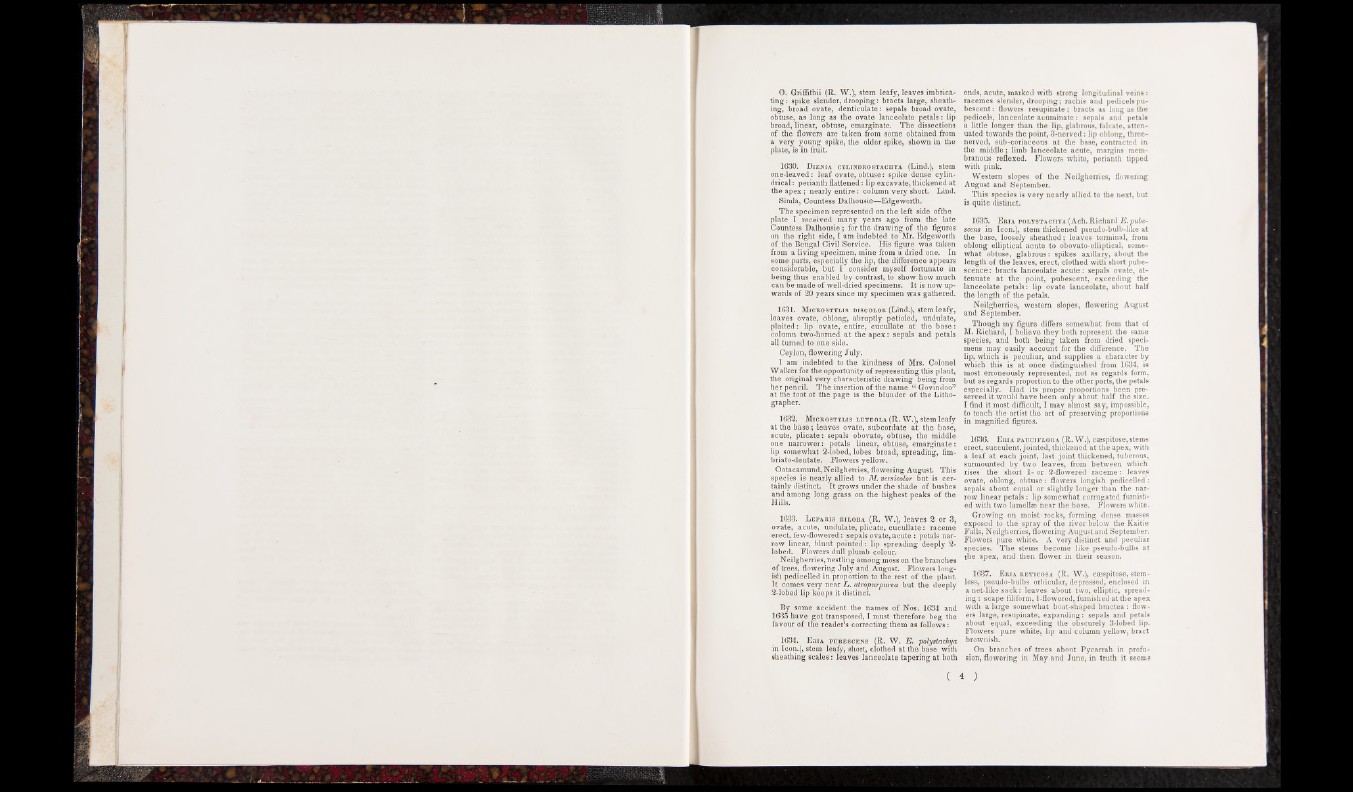
O. Griffith« (R. W.), stem leafy, leaves imbricating
: spike slender, drooping: bracts large, sheathing,
broad ovate, denticulate: sepals broad ovate,
obtuse, as long as the ovate lanceolate petals: lip
broad, linear, obtuse, emarginate. The dissections
of the flowers are taken from some obtained from
a very young spike, the older spike, shown in the
plate, is in fruit.
1630. Diejsia cylindrostachya (Lind.), stem
one-leaved: leaf ovate, obtuse: spike dense cylindrical
: perianth flattened: lip excavate, thickened at
the apex; nearly entire: column very short. Lind.
Simla, Countess Dalhousie—Edgeworth.
The specimen represented on the left side ofthe
plate I received many years ago from the late
Countess Dalhousie; for the drawing of the figures
on the right side, I am indebted to Mr. Edgeworth
of the Bengal Civil Service. His figure was taken
from a living specimen, mine from a dried one. In
some parts, especially the lip, the difference appears
considerable, but I consider myself fortunate in
being thus enabled by contrast, to show how much
can be made of well-dried specimens. It is now upwards
of 20 years since my specimen was gathered.
1631. Microstylis discolor (Lind.), stem leafy,
leaves ovate, oblong, abruptly petioled, undulate,
plaited: lip ovate, entire, cucullate at the base:
column two-horned at the apex: sepals and petals
all turned to one side.
Ceylon, flowering July.
I am indebted to the kindness of Mrs. Colonel
Walker for the opportunity of representing this plant,
the original very characteristic drawing being from
her pencil. The insertion of the name “ Govindoo”
at the foot of the page is the blunder of the Lithographer.
1632. Microstylis luteola (R. W.), stem leafy
at the base; leaves ovate, subcordate at the base,
acute, plicate: sepals obovate, obtuse, the middle
one narrower: petals linear, obtuse, emarginate:
lip somewhat 2-lobed, lobes broad, spreading, fim-
briato-dentate. Flowers yellow.
Ootacamund, Neilgherries, flowering August. This
species is nearly allied to M. versicolor but is certainly
distinct. It grows under the shade of bushes
and among long grass on the highest peaks of the
Hills.
1633. Leparis biloba (R. W.), leaves 2 or 3,
ovate, acute, undulate, plicate, cucullate: raceme
erect, few-flowered: sepals ovate, acute : petals narrow
linear, blunt pointed: lip spreading deeply 2-
lobed. Flowers dull plumb colour.
Neilgherries, nestling among moss on the branches
of trees, flowering July and August. Flowers long-
ish pedieelled in proportion to the rest of the plant.
It comes very near L . atropurpurea but the deeply
2-lobed lip keeps it distinct.
By some accident the names of Nos. 1634 and
1635 have got transposed, I must therefore beg the
favour of the reader’s correcting them as follows:
1634. Eria pubescens (R. W. E . polystachya
in Icon.), stem leafy, short, clothed at the base with
sheathing scales: leaves lanceolate tapering at both
ends, acute, marked with strong longitudinal veins:
racemes slender, drooping; rachis and pedicels pubescent
: flowers resupinate; bracts as long as the
pedicels, lanceolate acuminate: sepals and petals
a little longer than the lip, glabrous, falcate, attenuated
towards the point, 3-nerved: lip oblong, three-
nerved, sub-coriaceous at the base, contracted in
the middle; limb lanceolate acute, margins membranous
reflexed. Flowers white, perianth tipped
with pink.
Western slopes of the Neilgherries, flowering
August and September.
This species is very nearly allied to the next, but
is quite distinct.
1635. Eria polystachya (Ach. Richard E.pubescens
in Icon.), stem thickened pseudo-bulb-like at
the base, loosely sheathed; leaves terminal, from
oblong elliptical acute to obovato-elliptical, somewhat
obtuse, glabrous: spikes axillary, about the
length of the leaves, erect, clothed with short pubescence
: bracts lanceolate a c u te : sepals ovate, attenuate
at the point, pubescent, exceeding the
lanceolate petals: lip ovate lanceolate, about half
the length of the petals.
Neilgherries, western slopes, flowering August
and September.
Though my figure differs somewhat from that of
M. Richard, I believe they both represent the same
species, and both being taken from dried specimens
may easily account for the difference. The
lip; which is peculiar, and supplies a character by
which this is at once distinguished from 1634, is
most erroneously represented, not as regards form,
but as regards proportion to the other parts, the petals
especially. Had its proper proportions been preserved
it would have been only about half the size.
I find it most difficult, I may almost say, impossible,
to teach the artist the art of preserving proportions
in magnified figures.
1636. Eria pauciflora (R. W.), casspitose, stems
erect, succulent, jointed, thickened at the apex, with
a leaf at each joint, last joint thickened, tuberous,
surmounted by two leaves, from between which
rises the short 1- or 2-flowered raceme: leaves
ovate, oblong, obtuse: flowers longish pedieelled:
sepals about equal or slightly longer than the narrow
linear petals : lip somewhat corrugated furnished
with two lamellas near the base. Flowers white.
Growing on moist* rocks, forming dense masses
exposed to the spray of the river below the Kaitie
Falls, Neilgherries, flowering August and September.
Flowers pure white. A very distinct and peculiar
species. The stems become like pseudo-bulbs at
the apex, and then flower in their season.
1637. Eria reticosa (R. W.), emspitose, stemless,
pseudo-bulbs orbicular, depressed, enclosed in
a net-like sack: leaves about two, elliptic, spreading
: scape filiform, 1-flowered, furnished at the apex
with a large somewhat boat-shaped bra ctea: flowers
large, resupinate, expanding: sepals and petals
about equal, exceeding the obscurely 3-lobed lip.
Flowers pure white, lip and column yellow, bract
brownish.
On branches of trees about Pycarrah in profusion,
flowering in May and June, in truth it seems